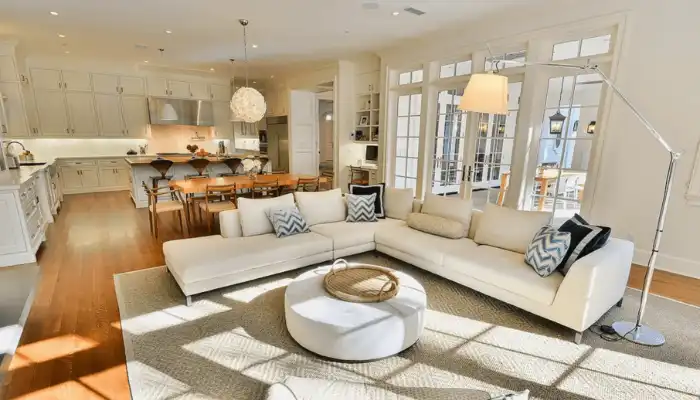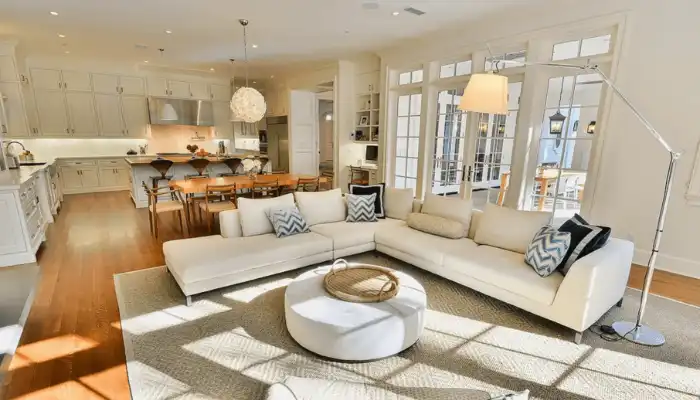
For decades, open concept living has been the dominant force in home design. It entails removing walls between traditionally separated spaces, such as kitchens and living rooms, to create a sense of space, light, and uninterrupted movement. However, our understanding of what defines a functional and comfortable home is changing with time due to changes in design trends. This article traces the history of open concept living as well as its continued relevance while also looking at some of the challenges that come with it and other alternatives that have emerged.

The Rise Of Open Concept Living: A Breath Of Fresh Air
The open concept movement started gaining momentum in the mid-20th century. Open floor plans provided a more contemporary and social approach to life as opposed to enclosed Victorian homes. Below are some factors that contributed to its initial appeal:
- A feeling of spaciousness: In smaller living areas, open floor plans give an impression of expansion.
- Enhanced natural light: With no barriers, sunlight penetrates deeper into the house making it brighter and more airy.
- Improved flow and connection: Family members or guests can interact freely so that they feel together.
- Greater flexibility: Easier remodeling for different purposes thus achieving various kinds of abodes.
Successful Implementations: Not every situation calls for this kind of arrangement. The following are examples:
i) Modern family homes – Open layouts allow parents in the kitchen to engage with children playing in the adjacent living space
ii) Loft apartments – Open floor plans maximize limited square footage by creating a sense of airiness
iii) Entertainment-focused living – Open plan allows easy flow between kitchen, dining room, and lounge areas ideal for hosting guests
Cracks in the Facade: Challenges of Open Concept Living
However widely embraced it may be, the open concept is not without criticism. Some critiques and obstacles related to this design approach include:
- Privacy concerns: In open layouts, finding a quiet spot to work from home, read, or simply enjoy solitude can be difficult.
- Noise issues: When there are no acoustic barriers sound from the kitchen, living room or even home entertainment systems can disrupt other rooms within the house.
- Defining spaces: Without any clear distinction between functional areas, open floor plans can become confusing.
- Maintenance challenges: Open spaces require constant vigilance when it comes to clutter control and maintaining a clean appearance, as the mess in one area is readily visible throughout the entire space.
Adapting to Changing Needs: The Evolution of Home Design
With changing modern ways of life also come different requirements for how we want our homes designed to cater to them. Emerging design trends focusing on the shortcomings of the open concept include:
- Shifting towards defined spaces: Spaces remain connected but with more distinct delineation through furniture arrangement, strategically placed low walls, or room dividers.
- The rise of semi-open concepts: This approach mixes some features of both closed and open layouts. As an example, a kitchen could be partially open to a living room by having a breakfast bar that separates them without interrupting traffic flow completely.
Technology to the rescue: The technology introduced in this smart house is a good example of how automated lighting and sound systems can be used to manage noise and create different moods and atmospheres within an open space.
Surveying the Landscape: Open Concept’s Prevalence and Popularity
The ideology behind open concept living isn’t just about design; it is a lifestyle. For years, National Association of Home Builders (NAHB) surveys have shown that most home buyers prefer open floor plans. Here are some key statistics:
- More than 80% of new homes built in the US incorporate open concept elements.
- Renovation projects often prioritize removing walls to create a more open layout.
- Open floor plans are particularly loved by young families and millennials who believe in connection and unity among members
Regional Variations: Even though it is dominated by an obsession with non-partitioned spaces, there are some regional variations across America when it comes to its popularity. Traditionally, warmer climates make use of open layouts for better air circulation and also bring indoors closer to outdoors. In contrast, cold regions could resort to using well-positioned walls aimed at enhanced heat retention.
Lifestyle Shifts and Design Preferences: The advent of open concept living is accompanied by changes in how we inhabit our dwellings today. Our homes no longer only serve as refuges in which we sleep; instead, they are places where people meet each other for entertainment, socialization, or even community building within the house itself. This desire for connectivity and interaction is what makes people choose houses with open layouts.
Creating Harmony: Design Solutions for Open Concept Living
Despite the undeniable advantages that come with having an open floor plan, certain issues such as privacy concerns, noise diffusion challenges, or setting boundaries between separate areas still arise from time to time. Here is how you can address these problems through ingenious design solutions:
Privacy Pockets:
- Sliding Doors: In one’s house, you can use the contemporary style sliding doors to separate any area including a home office or even a guest room for privacy reasons while at other times, you leave it open.
- Room Dividers: Decorative screens and free-standing bookshelves are some examples of stylish room dividers that will not only partition spaces but also maintain openness.
Managing the Noise:
- Strategic Furniture Placement: For example, turning back a sofa could help to visually separate the living area from where people eat in a house.
- Area Rugs: The strategic positioning of area rugs helps to define usage areas as well as provide visual and auditory distinction.
- Sound-Absorbing Materials: Such noise-dampening materials as textured wall panels or woven wall hangings can be added to this effect.
Maintaining Openness with Purpose:
- Multifunctional Furniture: Look for furniture pieces like ottomans that have storage compartments or modular sofas which can be rearranged to serve multiple purposes.
- Vertical Space Utilization: To define space and provide storage without taking too much floor space, build cabinets or install shelves on walls
- Clever Lighting: Overhead fixtures combined with strategically placed lamps create pools of light and define different areas within an open space through layered lighting.
Conclusion
Open concept living is characterized by bright rooms that foster connection and serve as pathways throughout the home. With regard to privacy issues or minimizing sound disturbance, smart designs should always guarantee functionality while keeping comfort intact in all layouts with no partitions. The timeless charm of open concept living lies in its ability to adapt to our changing lifestyles, hence making it one of today’s popular trends in modern houses.
